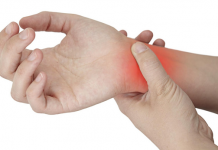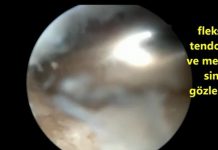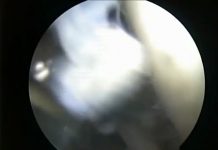DIAGNOSE AND TREATMENT LOGIC STRUCTURE REGARDING THE MASSES IN THE HANDS, WRISTS AND ARMS
1-Detection of the tumor: The time that the patients or patient relatives first detect the mass is noted.
2-History: most of the information that cannot be received with the moethods including the advanced technology can be acquired by the detailed history of the patient. The age of the patient is highly important in the differential diagnosis of the muscle-skeleton system tumors. Most of the tumor types are observed in some specific ages. The term of the mass and the syptoms are also important. Although generalising may be wrong, the rapid growth of the mass is a negative sign. Loss of weight, sweating at nights and decrease in the body resistance are also accepted as negative symptoms. The pain occuring at nights should be carefully examined. It indicates whether the pain is related with the movement and the usage of the joint. In this way, some pre-diagnosis regarding the abrasion of the joint are eliminated. Night (resting) pain does not indicate malign tumors, some rheumatismal and systemic diseases and infection may show similar symptoms.
3-Physical examination: The location and size of the mass, whether it moves, whether there is any color change on it and whether it is painful is noted during the examination. The place of the mass in the hand tumors is significant in terms of the diagnosis. For example, a mass observed on the wrist edge and found out to be liquid cystic with palpation is most probably a ganglion cyst. The depth of the mass is also important in diagnosis. Although generalizing may be wrong, we can say that superficially observed masses are most probably benign tumors. Whether the mass has pain or not cannot direct us. The mass may be benign but cause pain by pressuring the surrounding nerve tissues.
4-Radiological diagnosis methods: The following examination methods may not necessarily performed for each patient. Upon the completence of all the examination findings, the probable diagnoses are listed. The required examinations are performed in order to extablish the diagnosis, not to skip any probable diagnoses and to acquire more detailed information about the mass.
[auto_thumb width=”350″ height=”199″ link=”https://www.hakangundes.com.tr/wp-content/uploads/radyolojik-tetkikler1.jpg” lightbox=”true” align=”center” title=”” alt=”” iframe=”false” frame=”true” crop=”true”]https://www.hakangundes.com.tr/wp-content/uploads/radyolojik-tetkikler1.jpg[/auto_thumb]
A simple radiograophy (bilateral) of the mass area had better be taken.
From a wider perspective, the masses on the hands and arms can be divided into two cathegories. The masses originating from the bones and the masses originating from the soft tissues. If a mass is originating from the bone, the required information regarding the injury it causes and its progress can be ideally acquired with CT examination. If the same mass extends from the bone to the soft tissue, MR examination should be performed (figure 6). As general information, the information about the progress of a mass through the soft tissue (injury?) and the content of the soft tissue can be ideally acquired with MR examination.
The examination called scintigraphy simply shows the increase of blood stream in an area (figure 8). The evaluation of the scintigraphy as negative (normal blood stream) is generally a positive finding.besides, the evaluation of the scintigraphy as positive (increased blood stream) may ghave several reasons. Basically, even though the increase in the blood stream of a tumor tissue shows that the tumor has grown (active) and need more nutrition with blood; the findings acquired with scintigraphy never make sense alone. For example, arthrosis on the joint adjacent to the tumor may also show symptoms of increase in blood stream. The most important information acquired through scintigraphy is the detection of any other focuses with no symptoms in the patient’s body except the bone havign the current complaints. If there is no such a focus, a detailed examination can be performed with CT and/or MR.
Recent studies gives some information questioning the benefits acquired by chest x-ray. There are some studies indicating that chest tomography should be preffered instead. It should not be forgotten that the rate of radiation will be more in tomography. The malign (sarcoma) tumors originating from muscle-sceleton system spread by blood instead of lymph as differently from all other tumors (carsinoma=cancer) originating from the other parts of the body. Based on this highly generalized information, if there is any spread, it is assumed to be on the lung tissue at first. In the staging period, if the chest tomograaphy and scintigraphy is evaluated as “clear”, it is accepted that there is no other distantn spread.
5-Laboratory findings: It can provide important information about the general condition of the patient. Erythrocyte sedimentation rate (ESR) is a sensitive but non-characteristic screening test. In other words, normal levels of ESR is important for the patient. High level of ESR means something wrong in the body but in order to find out this, more examinations should be performed. There are several diagnoses from infection to rheumatismal diseases in the differential diagnosis of high ESr level. Besides, in most of the patients having high livel of ESR, no specific reason is detected. CRP (C Reactive Protein) test indicates the pathologies originating from infection but it is also a non-characteristic laboratory test. Whole blood count is important to show the general condition of the patient.
6-Differential diagnosis: After all the examinations are performed, a diagnose is established in the light of the acquired findings. This is called pre-diagnosis.
7-Tissue biopsy: In order to verify the pre-diagnosis, a sample should be taken from the tissue and examined under microscope. This is called biopsy. General information about the biopsy is indicated above.
8-Staging: Upon the biopsy, the tissue diagnosis is established and together with the information acquired from the previously performed examinations, the stage of the disease is detected.
9-Treatment: Three main clasic methods in the treatment are surgical treatment, chemotherapy and radiotherapy. The planning of the treatment is made in accordance with the tissue diagnosis and the stage of the disease. It is difficult to summarize this stage which constitute a subject to a book. However, the main point that the patient should be aware of is that implementation or non-implementation of chemotherapy, radiotherapy or surgical treatment for a patient is not a sign of a bad stage of the disease. There are some tumors that are applied radiotheraoy and/or chemotherapy in early stages. Howeveri in some tumors, the main treatment method is the surgery. As indicated above, it is decided after staging and tissue biopsy.
DIAGNOSE AND TREATMENT LOGIC STRUCTURE: SUMMARY
Detection of the tumor
History
Physical examination:
Diagnosing methods:
– Simple direct radiography: Always should be performed. MR (manyetik rezonans) İnceleme.
– CT (computerized tomography).
– Scintigraphy.
– Chest x-ray
– Chest and/or abdomen tomography.
– PET (positron-emission tomography)
Laboratory examinations
– Whole blood count
– ESR (erythrocyte sedimentation rate)
– Alkaline phosphatase
– Serum calcium level
– PSA (prostate enzyme, for men)
Serum immunoelectrophoresis
Whole urine examination
Differential diagnosis
Tissue biopsy
– Staging
– Treatment
– Surgical treatment
– Chemotherapy
– Radiotherapy
Not all of the aforementioned diagnosing methods should be performed for each patient. Your orthopedic surgeon shall make the decision in accordance with the mass and patient conditions. Otherwise, the patient will encounter a lot of unnecessary moral and financial load. For example, ın some tumors originating from soft tissue, CT will not provide any additional information for the treatment while it will maket he patient be subjected to the radiation unnecessarily.
Below, you can find a list of the tumors observed more frequently on the hands and the arms which is taken from a book. As it can be understood from the list, even though the names can be confusing and frigthening, most of them are benign tumors. As it is previously specified, the information given here is general information. No virtual information can substitute for the information acquired by negotiating with the doctor face to face.












